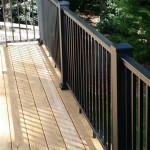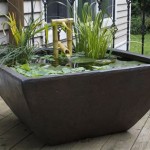How To Clean A Concrete Patio: A Comprehensive Guide
A concrete patio serves as an extension of living space, providing an area for relaxation, entertainment, and outdoor dining. However, exposure to the elements, including dirt, grime, algae, and mold, can diminish its aesthetic appeal and create a potentially hazardous surface. Regular cleaning is essential to maintain the patio's appearance, prevent deterioration, and ensure a safe environment. This article provides a detailed guide on how to effectively clean a concrete patio, covering various methods and tools for achieving optimal results.
Before initiating the cleaning process, it is crucial to assess the condition of the concrete and identify the type of stains present. This assessment informs the selection of appropriate cleaning agents and techniques. Factors to consider include the age of the concrete, the presence of cracks or damage, and the severity of staining. Understanding these factors will ensure that the cleaning process is effective and does not cause further damage.
Preparation is a critical step in any cleaning project. Removing furniture, potted plants, and other items from the patio area creates unobstructed access for cleaning. Sweeping the surface with a stiff-bristled broom removes loose debris, such as leaves, twigs, and dirt. This initial sweeping prevents these materials from becoming embedded in the concrete during the cleaning process, which would make stain removal more difficult.
Gathering Necessary Supplies and Equipment
Effective concrete patio cleaning requires the right tools and supplies. The selection of these items depends on the chosen cleaning method and the severity of the stains. A basic cleaning may only require a garden hose, bucket, and cleaning solution, while more intensive cleaning may necessitate a pressure washer and specialized concrete cleaners.
A stiff-bristled brush is essential for scrubbing the concrete surface. The brush should be durable enough to withstand repeated use and effectively agitate the cleaning solution. A long handle provides added reach and reduces strain on the back during scrubbing. Options include push brooms with durable bristles or specialized scrub brushes designed for concrete surfaces. A garden hose with a spray nozzle allows for rinsing the patio after cleaning. The nozzle should offer adjustable spray patterns, ranging from a gentle shower to a concentrated stream. This flexibility allows for efficient rinsing without damaging the concrete.
Cleaning solutions tailored for concrete surfaces are available from various retailers. These solutions typically contain detergents and degreasers designed to break down dirt, grime, and oil stains. When selecting a cleaning solution, it is essential to consider its compatibility with the concrete and its environmental impact. Environmentally friendly options are available that are biodegradable and pose minimal risk to plants and animals. For stubborn stains, specialized concrete stain removers may be necessary. These products are formulated to target specific types of stains, such as oil, rust, or mildew.
A pressure washer can significantly expedite the cleaning process and improve results, particularly for heavily soiled patios or those with ingrained stains. Pressure washers use high-pressure water to blast away dirt and grime. However, using a pressure washer requires caution, as excessive pressure can damage the concrete surface. It is crucial to select the appropriate nozzle and pressure setting for the specific type of concrete and the severity of the stains. Always begin with a low-pressure setting and gradually increase it as needed. Safety glasses and gloves are essential when using a pressure washer to protect against debris and potential skin irritation.
Methods for Cleaning a Concrete Patio
Several methods can be employed to clean a concrete patio, each offering different levels of effectiveness and ease of use. The choice of method depends on the severity of the staining, the available equipment, and personal preferences. It is important to consider the pros and cons of each method before proceeding.
One of the simplest and most economical methods involves using a mixture of water and dish soap. This method is suitable for light cleaning and removing surface dirt. Mix a small amount of dish soap with warm water in a bucket. Apply the soapy water to the patio surface using a mop or brush. Scrub the concrete with a stiff-bristled brush to loosen dirt and grime. Rinse the patio thoroughly with a garden hose to remove all traces of soap. This method is gentle and safe for most concrete surfaces.
For more stubborn stains, a solution of water and vinegar can be effective. Vinegar is a natural cleaning agent that can help to break down dirt and grime. Mix equal parts water and white vinegar in a bucket. Apply the vinegar solution to the patio surface and let it sit for 15-20 minutes. Scrub the concrete with a stiff-bristled brush to loosen dirt and grime. Rinse the patio thoroughly with a garden hose. Vinegar is a relatively mild acid, but it is essential to avoid prolonged contact with the skin and eyes.
Commercial concrete cleaners are formulated to effectively remove stubborn stains, such as oil, rust, and mildew. These cleaners typically contain detergents, degreasers, and other chemicals that break down dirt and grime. Follow the manufacturer's instructions carefully when using a commercial concrete cleaner. Apply the cleaner to the patio surface, allow it to sit for the recommended time, and then scrub with a stiff-bristled brush. Rinse the patio thoroughly with a garden hose. Always wear gloves and eye protection when using commercial concrete cleaners.
A pressure washer can be used to clean a concrete patio quickly and efficiently. However, it is essential to use the pressure washer correctly to avoid damaging the concrete surface. Select the appropriate nozzle and pressure setting for the type of concrete and the severity of the stains. Start with a low-pressure setting and gradually increase it as needed. Hold the nozzle at a distance of at least 12 inches from the concrete surface and move it in a sweeping motion. Avoid concentrating the pressure on one spot for too long, as this can damage the concrete. Rinse the patio thoroughly with a garden hose after pressure washing to remove any remaining dirt and grime. For tough stains, a concrete cleaner can be applied before pressure washing to enhance the cleaning power.
Addressing Specific Types of Stains
Different types of stains require different cleaning approaches. Identifying the type of stain is crucial for selecting the appropriate cleaning method and achieving optimal results. Understanding the nature of the stain allows for targeted treatment and effective removal.
Oil stains are a common problem on concrete patios, often resulting from spills from vehicles or outdoor cooking equipment. To remove oil stains, start by applying a generous amount of absorbent material, such as kitty litter or cornstarch, to the stain. Let the absorbent material sit for several hours or overnight to absorb the oil. Sweep or vacuum up the absorbent material. If the stain persists, apply a commercial concrete degreaser to the affected area. Follow the manufacturer's instructions carefully. Scrub the area with a stiff-bristled brush and rinse thoroughly with a garden hose. Repeat the process if necessary.
Rust stains can be caused by metal objects left on the patio surface or by irrigation systems. To remove rust stains, apply a commercial rust remover to the affected area. Follow the manufacturer's instructions carefully. Scrub the area with a stiff-bristled brush and rinse thoroughly with a garden hose. Alternatively, a solution of lemon juice and salt can be used to remove rust stains. Apply the lemon juice and salt to the stained area, let it sit for a few minutes, and then scrub with a brush. Rinse thoroughly with a garden hose.
Mildew and algae growth is common in damp or shady areas. To remove mildew and algae, apply a solution of bleach and water to the affected area. Mix one part bleach with three parts water in a bucket. Apply the bleach solution to the patio surface and let it sit for 15-20 minutes. Scrub the concrete with a stiff-bristled brush to loosen the mildew and algae. Rinse the patio thoroughly with a garden hose. Exercise caution when using bleach, as it can damage plants and discolor concrete. Always wear gloves and eye protection when handling bleach.
Leaves and organic matter can stain concrete over time. These stains often appear as dark or discolored patches. To remove these stains, sweep away any remaining leaves and debris. Apply a solution of water and oxygen bleach (sodium percarbonate) to the affected area. Oxygen bleach is a safer alternative to chlorine bleach. Follow the manufacturer's instructions for mixing the solution. Let the solution sit on the stain for several hours or overnight. Scrub the area with a stiff-bristled brush and rinse thoroughly with a garden hose. This method may require multiple applications for stubborn stains.
Following the cleaning, it is important to allow the patio to dry completely. This prevents the re-accumulation of dirt and grime. Once dry, consider applying a concrete sealer to protect the surface from future stains and damage. A concrete sealer will help to repel water, oil, and other substances, making it easier to clean in the future. Select a sealer that is appropriate for the type of concrete and the level of protection desired. Applying a sealer can significantly extend the life of the concrete patio and maintain its appearance.

How To Clean Concrete The Easy Way Porches Patios Driveways More Run Radiance

Best Way To Clean A Concrete Patio Chalking Up Success

Diy Miracle Concrete Patio Cleaner I Should Be Mopping The Floor

The Easiest Way To Clean A Concrete Patio My Creative Days

How To Clean A Concrete Patio Maintenance Tips Network

6 Easy Ways To Clean Your Concrete Patio For Spring

Diy Miracle Concrete Patio Cleaner I Should Be Mopping The Floor

30 Ways To Use Natural Baking Soda In The Garden Concrete Patio Clean Cleaner

Diy Concrete Patio Makeover The Frugal South

Diy Miracle Concrete Patio Cleaner I Should Be Mopping The Floor
Related Posts








